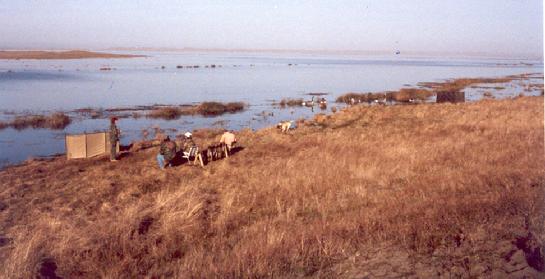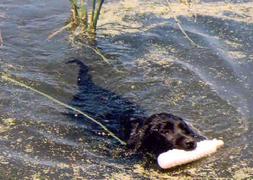Starting Out In Field Work With Your Lab
The most important thing to start with is patience: if you don't have a LOT of patience, find something else to do with your dog. That said, before your first day in the field, I would recommend that you attend (as an observer) either a Working Certificate test or an AKC Hunting Test for Retrievers. These events will give you a good idea of what a lab can do, and you will also see that dogs don't always do what their handlers expect them to.
Buy at least one or two books on field training - "Working Certificate Training for Retrievers" is a good basic book. Basic equipment needed includes the following: (1) a complete set of extra clothes, including shoes, to be kept in your vehicle, (2) shade cloth, (3) a water bucket and one gallon of water, (4) a flat buckle collar (NO CHOKE CHAINS) and lead, (5) a few regular size white bumpers, (6) a crate for your dog, (7) a whistle and lanyard, and (8) a supply of old bath towels. If you have game birds (dead or alive) add them to your list.
|
 |
| Crescent City - the first Hunting Retriever Test held in California: Kathy running Windham |
|
|
On your dog's first day in the field, do not expect him to do much other than check out the new smells and terrain. Taking him out for a long walk and seeing if he is interested in getting wet may be all that you do on your first trip.
| |
After your dog is comfortable and generally familiar with these new surroundings, try thowing a few short (20') bumpers for him. Use your whistle to call him back to you. If you have not worked on basic retrieving (which means fetching AND BRINGING IT BACK), your dog may run out to the bumper, bump it with his nose and run back to you. You can work on basic concepts in your backyard or a hallway. Throw a short bumper and give the dog a lot of praise when he brings it back to you. Once your dog is retrieving, you will find it is most helpful if you have a training partner who can throw bumpers for your dog. This will be crucial once your dog gets the basics down, and you want to start doing longer retrieves. The basic obedience commands that I teach are "come", "sit", "fetch", "give", and "heel". Your dog should be familiar with these commands prior to your first field training day.
|
To introduce a dog to water for the first time, the easiest way is to have him follow another dog into the water after a bumper. If this is not possible, plan on spending a day playing in the water with your dog, giving lots of encouragement once he has discovered that he can swim. DO NOT FORCE THE ISSUE! Throw short (3') bumpers into the water and give lots of encouragement and praise when your dog goes in and retrieves them. Make it fun. If your dog is hesitant, let it go and try again later.
|
 |
| 4 months |
|
| |
To make a day in the field productive, know exactly what you want to accomplish before you get out there. You may want to include the following concepts in your training schedules; (1) marking (land retrieves of varying lengths), (2) hunting in cover, (3) crossing barriers (roads, irrigation pipes, changes of cover), (4) up and down hills, (5) guns at the line and in the field, (6) duck calls, (7) retrieves in deep shadows, (8) long open water marks, (9) marks in and behind tules, (10) land/water/land marks and water/land/water marks, and (11) decoys.
A final word, field training is accomplished in small steps. Don't expect instant results, and if you and your dog aren't having fun, go home!
|
|
|